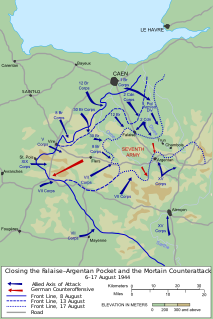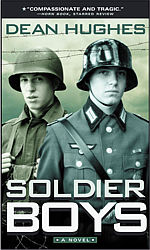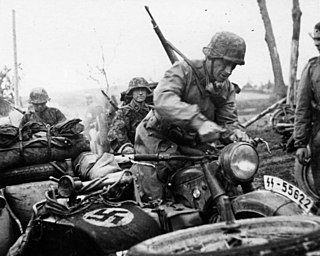
The Malmedy massacre was a war crime committed by members of Kampfgruppe Peiper, a German combat unit led by Joachim Peiper, at Baugnez crossroads near Malmedy, Belgium, on December 17, 1944, during the Battle of the Bulge. According to numerous eyewitness accounts, 84 American prisoners of war were massacred by their German captors: the prisoners were assembled in a field and shot with machine guns.

Hamilton Fish III was a soldier and Republican politician from New York State. Born into a family long active in the state, he served in the United States House of Representatives from 1920 to 1945 and during that time was a prominent opponent of United States intervention in foreign affairs and was a critic of President Franklin D. Roosevelt. When Fish celebrated his 102nd birthday in 1990, he was the oldest living American who had served in Congress.

The Italian Campaign of World War II consisted of Allied operations in and around Italy, from 1943 to 1945. The Joint Allied Forces Headquarters (AFHQ) was operationally responsible for all Allied land forces in the Mediterranean theatre and it planned and led the invasion of Sicily in July 1943, followed in September by the invasion of the Italian mainland and the campaign in Italy until the surrender of the German Armed Forces in Italy in May 1945.

The Falaise Pocket or Battle of the Falaise Pocket was the decisive engagement of the Battle of Normandy in the Second World War. A pocket was formed around Falaise, Calvados, in which the German Army Group B, with the 7th Army and the Fifth Panzer Army were encircled by the Western Allies. The battle is also referred to as the Battle of the Falaise Gap, the Chambois Pocket, the Falaise-Chambois Pocket, the Argentan–Falaise Pocket or the Trun–Chambois Gap. The battle resulted in the destruction of most of Army Group B west of the Seine, which opened the way to Paris and the Franco-German border for the Allied armies on the Western Front.

The Italian resistance movement is an umbrella term for Italian resistance groups during World War II. It was opposed to the forces of Nazi Germany as well as their puppet state local regime, the Italian Social Republic, especially following the German military occupation of Italy between September 1943 and April 1945, though the resistance to the Fascist Italian government began even prior to World War II. The movement that rose among Italians of various social classes is also known as the Italian resistance and the Italian partisans, and the brutal conflict they took part in is referred to as the Italian Liberation War or as the Italian Civil War. The modern Italian Republic was declared to be founded on the struggle of the Resistance.
The Dachau liberation reprisals were a series of incidents in which German prisoners of war were killed by American soldiers and concentration camp internees at the Dachau concentration camp on April 29, 1945, during World War II. It is unclear how many SS members were killed in the incident but most estimates place the number killed at around 35–50. In the days before the camp's liberation SS guards at the camp had forced 7,000 inmates on a death march that resulted in the death of many from exposure and shooting. When Allied soldiers liberated the camp, their reactions varied from being shocked, horrified, disturbed, and angered by the masses of dead they found and the combativeness of some of the remaining German guards who had allegedly fired on them.

Saints and Soldiers is a 2003 war drama film directed by Ryan Little and starring Corbin Allred, Alexander Niver, Kirby Heyborne, Lawrence Bagby, and Peter Asle Holden. It is loosely based on events that took place after the Malmedy massacre during the Battle of the Bulge, where four U.S. soldiers and a downed British airman need to reach Allied lines to pass on some vital intelligence. The film received mostly positive reviews. It was followed by Saints and Soldiers: Airborne Creed and Saints and Soldiers: The Void.

The Siege of Budapest or Battle of Budapest was the 50-day-long encirclement by Soviet forces of the Hungarian capital of Budapest, near the end of World War II. Part of the broader Budapest Offensive, the siege began when Budapest, defended by Hungarian and German troops, was first encircled on 26 December 1944 by the Red Army and the Romanian Army. During the siege, about 38,000 civilians died through starvation or military action. The city unconditionally surrendered on 13 February 1945. It was a strategic victory for the Allies in their push towards Berlin.
Allied war crimes include both alleged and legally proven violations of the laws of war by the Allies of World War II against either civilians or military personnel of the Axis powers.
The 14th Waffen Grenadier Division of the SS , Ukrainian: 14а Гренадерська Дивізія СС ), prior to 1944 titled the 14th SS-Volunteer Division "Galicia" was a World War II German military formation made up predominantly of military volunteers with a Ukrainian ethnic background from the area of Galicia, later also with some Slovaks and Czechs. Formed in 1943, it was largely destroyed in the battle of Brody, reformed, and saw action in Slovakia, Yugoslavia and Austria before being renamed the first division of the Ukrainian National Army and surrendering to the Western Allies by 10 May 1945.

Kleisoura is a traditionally Aromanian (Vlach) settlement and a former municipality in Kastoria regional unit, West Macedonia, Greece. Since the 2011 local government reform, it is part of the municipality of Kastoria, of which it is a municipal unit. The municipal unit has an area of 37.069 km2. Population 259 (2011).

The Bronze Soldier is the informal name of a controversial Soviet World War II war memorial in Tallinn, Estonia, built at the site of several war graves, which were relocated to the nearby Tallinn Military Cemetery in 2007. It was originally named "Monument to the Liberators of Tallinn", was later titled to its current official name "Monument to the Fallen in the Second World War", and is sometimes called Alyosha, or Tõnismäe monument after its old location. The memorial was unveiled on 22 September 1947, three years after the Red Army reached Tallinn on 22 September 1944 during World War II.

"From Yesterday" is a song by American rock band Thirty Seconds to Mars, and the third single released from their second album A Beautiful Lie. The song impacted radio on October 17, 2006. The music video for the song is believed to be the first ever American music video shot in the People's Republic of China in its entirety. The music video is also the last video by the band to feature bass player Matt Wachter. The song won the Kerrang! Award for Best Single.
Horst Günther was a German World War II prisoner of war. An Afrika Korps gefreiter, he was "captured on 9 May 1943 in Tunisia [and] murdered in Camp Aiken prisoner-of-war camp, South Carolina" United States.

Baron Otto Gustav von Wächter was an Austrian lawyer, Nazi politician and a high-ranking member of the SS, a paramilitary organisation of the Nazi Party.

During World War II, some members of the United States military mutilated dead Japanese service personnel in the Pacific theater of operations. The mutilation of Japanese service personnel included the taking of body parts as "war souvenirs" and "war trophies". Teeth and skulls were the most commonly taken "trophies", although other body parts were also collected.

Le Val-de-Guéblange is a commune in the Moselle department in Grand Est in north-eastern France.

Soldier Boys is a 2001 novel by writer Dean Hughes. The story is set during World War II and tells the story of two teenagers, one American, the other German, who join their respective armies and fight at the Battle of the Bulge.

James Buchanan "Bucky" Barnes is a fictional superhero appearing in American comic books published by Marvel Comics. Originally introduced as a sidekick to Captain America, the character was created by Joe Simon and Jack Kirby and first appeared in Captain America Comics #1 as the original and most well-known incarnation of "Bucky". The character is brought back from supposed death as the brainwashed assassin Winter Soldier, and later assumed the role of Captain America when Steve Rogers was presumed to be dead.

Garay Latif oglu Asadov was an Azerbaijani Red Army sergeant and a posthumous Hero of the Soviet Union. Asadov was posthumously awarded the title on 24 March 1945 for his actions during the Debrecen Offensive Operation. He was reported to have killed 16 German soldiers and was killed while covering a bunker opening with his body.




















